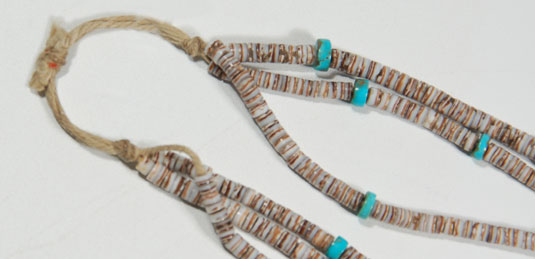Three Strand Turquoise and Shell Hieshe Necklace with Appendages [SOLD]
+ Add to my watchlist Forward to Friend
- Category: Necklaces
- Origin: KEWA, Santo Domingo Pueblo
- Medium: shell hieshe, turquoise, stone
- Size: 28 inches end-to-end
- Item # C3710B SOLD

The Anasazi are the ancient ones, the ones who preceded the contemporary pueblo peoples. At an Anasazi ruin in Utah in 1960, archaeologists unearthed a burial of a female who had passed away around circa 1100. Around the neck of the remains was a beautiful turquoise necklace. Necklaces such as this are still the most favored among the Pueblo people of today.
From the earliest of times, turquoise has been favored by the Pueblo Indians of the Southwest. They mined it at Cerrillos, about 30 miles south of Santa Fe, for centuries. Turquoise had religious, ceremonial, superstitious and economic values to the Pueblo Indians.
Bits of turquoise were put in bearing beams of buildings to strengthen them, offerings of turquoise were made at sacred shrines, Medicine Men used it in diagnostic and healing rituals, and it was often used in burials. It is a unique sign of wealth and is seen in abundance at ceremonial dances at the pueblos of New Mexico. The dominant shell among the Anasazi from the earliest periods on was the Olivella. It seems to have come from the Gulf of California.
The turquoise and shell (hieshe) necklaces are constructed in a most interesting manner. The shell is cut into small, often square pieces, drilled and strung on string, then slowly and meticulously rolled over sandstone until each piece is round and all the pieces are of the same diameter. In this necklace, the turquoise beads were treated in the same manner and then the shell and turquoise were strung on cotton twine. Cotton is used because it is softer and doesn’t wear against the shell too abrasively.
If one goes to any pueblo feast day plaza dance, it is this style necklace one sees on all the dancers—male and female, adult and child. It possesses powers not equaled by silver jewelry.
This Kewa Pueblo (Santo Domingo) necklace has two additional items usually seen only on necklaces that were made for use by a pueblo person. One of the items is a white bear carved from what may be alabaster and the other is a small turquoise drilled bead. Such fetishes are added to necklaces to strengthen their power when used at a pueblo.
Condition: excellent original condition
Recommended Reading: Indian Jewelry of the American Southwest by Sarah Peabody & William A. Turnbaugh. This book is currently not available from Adobe Gallery
Provenance: from the estate of Frances Balcomb passed down through the family

- Category: Necklaces
- Origin: KEWA, Santo Domingo Pueblo
- Medium: shell hieshe, turquoise, stone
- Size: 28 inches end-to-end
- Item # C3710B SOLD



